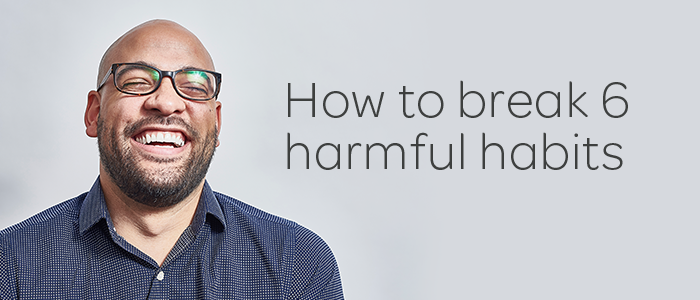Winter 2019-2020
How to break 6 harmful habits
 ;
;
All it takes is one bad habit to undo some of the results of your good oral health routine — like brushing twice a day and flossing daily. Fortunately, it’s never too late to break a less than healthy habit. If any of these behaviors sound familiar to you, here’s how to stop them.

Chewing and biting things other than food
It’s no surprise that these habits can scratch, crack or chip your teeth or damage a filling:
- Biting your nails
- Crunching ice
- Holding pins in your mouth
- Chewing on writing instruments
- Using your teeth to open packages
These behaviors can also wear down tooth enamel and irritate soft tissues inside teeth — causing regular toothaches.
Try this:
- Hold something in your hands — like a stress ball — to keep from biting your nails.
- Drink beverages chilled without ice or use a straw to avoid chewing ice.
- Try sugar-free gum when you’re tempted to chew on other things. It helps strengthen teeth while reducing plaque and tooth decay.
- Keep scissors, bottle openers and pin cushions handy to avoid using your teeth as a tool.

“Flossing” without floss
Flossing every day is an important part of your oral health routine. But only when you use actual floss. People have reported using unusual items to remove food from teeth, such as fingernails, cutlery, safety pins and strands of hair. In addition to being ineffective, many of these items are obviously unsafe and unsanitary. Not only can they cause injury or fill your mouth with germs, but 42% of people who used unusual items to floss said it caused them pain.
Try this:
- Buy extra floss to keep handy when you are on-the-go.
- In addition to keeping floss at home, store some in your purse, vehicle and workplace.

Brushing too soon after eating something acidic
While it’s crucial to your oral health to brush twice a day, brushing right after a meal is not always ideal.
If you have consumed something with citric acid like limes, lemons, grapefruits or oranges, you can damage tooth enamel by brushing too soon.
Try this:
-
Brush your teeth before eating something acidic and then drink a glass of water after eating to rinse away acids. Or wait at least 30 minutes after eating to brush.

Not maintaining your toothbrush properly
Good oral health doesn’t stop with brushing. If you store your toothbrush in a closed space like a drawer, bacteria can build up and produce acids that cause cavities and gum disease.
If you continue using the same toothbrush for too long, it won’t remove as much plaque, which could lead to cavities.
Try this:
- After every use, rinse your toothbrush and store in a vertical position in the open air where it is not touching other toothbrushes.
- Get a new toothbrush or toothbrush head at least every three to four months or if the bristles look frayed or worn.
Avoid germs by storing your toothbrush far enough from the sink to prevent splashing and at least four feet away from the toilet.

Sharing cups, straws and eating utensils
If you share cups, straws or silverware, you’re also sharing germs.
You can spread cold and flu germs along with other diseases through the mouth. You might also harm little ones’ developing teeth by spreading cavity-causing bacteria to them.
Try this:
- Don’t share anything that has touched your mouth or vice versa.
- Make sure you don’t taste the food on your baby’s spoon, blow on their food, clean their pacifier with your mouth or kiss them on the lips.,/li>

Vaping
A recent outbreak of lung disease and death linked to vaping has made it clear that e-cigarettes are not a safe alternative to regular cigarettes.
Vaping also stains teeth, causes dry mouth and makes it easy for bacteria to collect in your mouth. This can lead to cavities, tooth loss and gum disease.
Try this:
- Ask your dentist or physician for help quitting.
- Don’t take your e-cigarette with you when you leave home for the day.
- Try to understand what causes you to reach for an e-cigarette.
- Develop a strategy to help you not give into cravings.
- Ask friends and family for support along the way.
Previous story
5 ways to restart your New Year's resolutions
Copyright © 2026 Moda Partners, Inc. All rights reserved.

